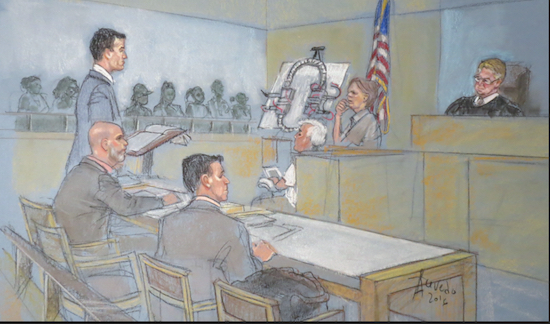SKETCHES OF COURT: Verdict in favor of electrocuted plaintiff in labor law trial

In this courtroom sketch, Hon. Edgar Walker listens as plaintiff’s attorney Dominique Penson (standing), of the law firm Barasch, McGarry, Salzman & Penson, conducts a direct examination in the labor law trial John Anthony Hegarty v. BG National Plumbing & Heating, City of New York, NYC Dept. of Education, and the NYC School Construction Authority. Penson is accompanied by co-counsel Bruce Kaye, at left.
In July of 2010, a renovation project was underway at I.S. 291 in Bushwick, which included an upgrade to the school’s air conditioning system. The work was interrupted by the unexpected discovery of electrical conduit pipes encased in concrete that were being cleared for the installation of ducts. Hegarty, a journeyman-electrician, was employed by the subcontractor tasked with rerouting the wiring.
In order to accommodate rather than relocate the renovation, the rigid conduits would be cut and replaced with flexible and longer conduits that could be fitted around the ductwork, and Hegarty would splice in additional wiring. Hegarty, who is pictured on the witness stand, is seated before a display depicting a conduit such as the one on which he was working.

Brooklyn Boro
View MoreNew York City’s most populous borough, Brooklyn, is home to nearly 2.6 million residents. If Brooklyn were an independent city it would be the fourth largest city in the United States. While Brooklyn has become the epitome of ‘cool and hip’ in recent years, for those that were born here, raised families here and improved communities over the years, Brooklyn has never been ‘uncool’.